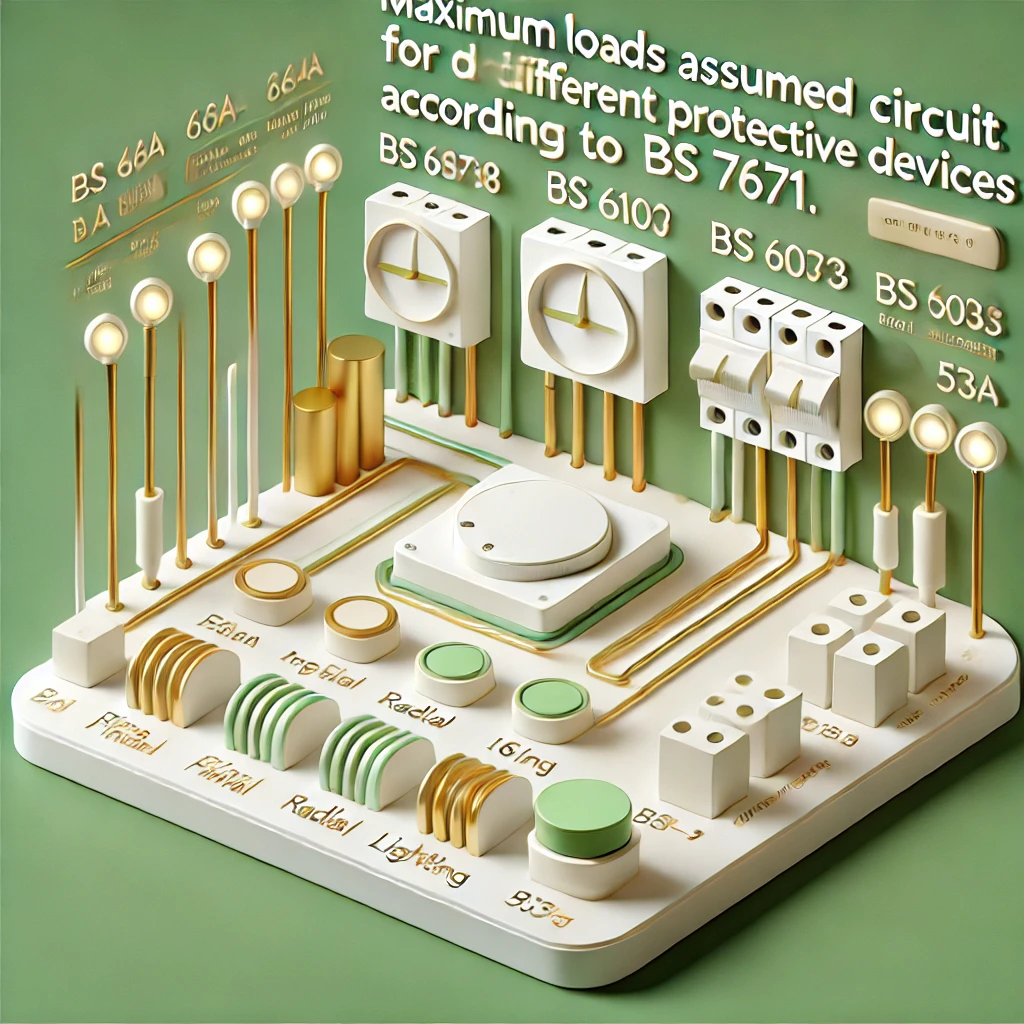Understanding Maximum Loads Assumed per Circuit for Different Protective Devices According to BS 7671
According to BS 7671, On-Site Guide Page 74 Table 7.1 i outlines the maximum loads assumed per circuit for various protective devices, providing critical guidelines for electricians to ensure safe and compliant installations.

OW London Electrician and Home Automation Engineers Team
Understanding Maximum Loads Assumed per Circuit for Different Protective Devices According to BS 7671
Regulation BS 7671 Table 7.1(i)
BS 7671 Table 7.1(i) provides a critical reference for electricians to ensure that circuit designs are safe and compliant with UK wiring regulations. It outlines the maximum loads that can be assumed per circuit for different types of protective devices, including those conforming to standards such as BS 3036, BS 60898, BS 61009, BS 88-3, and BS 88-2. This table is essential for preventing circuit overloads and ensuring the safety of electrical installations.
Table 7.1(i) Maximum Loads Assumed per Circuit
| Protective device | Rating (A) | Circuit type | Load (A) |
|---|---|---|---|
| BS 3036 | 30 | Ring final circuit | 26 |
| BS 60898, BS 61009, BS 88-3, BS 88-2 | 32 | Ring final circuit | 26 |
| BS 3036 | 5 | Lighting | 5 |
| BS 60898, BS 61009, BS 88-3, BS 88-2 | 6 | Lighting | 5 |
| BS 60898, BS 61009, BS 88-3, BS 88-2 | 10 | Lighting | 8 |
| BS 60898, BS 61009, BS 88-3, BS 88-2 | 16 | Lighting | 12.8 |
| BS 3036, BS 88-3 | 5 | Radial | 5 |
| BS 60898, BS 61009, BS 88-3, BS 88-2 | 6 | Radial | 5 |
| BS 60898, BS 61009, BS 88-2 | 10 | Radial | 8 |
| BS 3036 | 15 | Radial | 14.6 |
| BS 60898, BS 61009, BS 88-3 | 16 | Radial | 14.6 |
| BS 60898, BS 61009, BS 3036, BS 88-2, BS 88-3 | 20 | Radial | 16 |
| BS 60898, BS 61009, BS 88-2 | 25 | Radial | 20 |
| BS 3036 | 30 | Radial | 26 |
| BS 60898, BS 61009, BS 88-3 | 32 | Radial | 26 |
| BS 60898, BS 61009, BS 88-2 | 40 | Radial | 37 |
Frequently Asked Questions
Q: What is the maximum load allowed for a 32A protective device in a ring final circuit?
A: According to BS 7671 Table 7.1(i), the maximum load assumed for a 32A protective device in a ring final circuit is 26A. This applies to devices such as BS 60898, BS 61009, BS 88-3, and BS 88-2.
Example: If you're wiring a ring final circuit for a kitchen, and you plan to install a 32A circuit breaker (BS 60898), the total load of appliances connected to the circuit (like a refrigerator, oven, and dishwasher) should not exceed 26A to prevent overloading the circuit.
Q: What is the maximum load assumed for a 6A circuit breaker used in a lighting circuit?
A: As per BS 7671 Table 7.1(i), the maximum load assumed for a 6A circuit breaker in a lighting circuit is 5A. This is consistent for BS 60898, BS 61009, BS 88-3, and BS 88-2 devices.
Example: If you're installing lighting in a living room and using a 6A circuit breaker, the combined wattage of all the lights should not exceed 1150 watts (since 230V * 5A = 1150W), assuming standard 230V mains voltage.
Q: For a radial circuit using a BS 3036 30A fuse, what is the maximum load considered?
A: The BS 7671 Table 7.1(i) specifies that the maximum load assumed for a radial circuit protected by a BS 3036 30A fuse is 26A.
Example: In a radial circuit supplying power to multiple power outlets in a garage, if you're using a BS 3036 30A fuse, ensure that the total current drawn by all the tools and equipment does not exceed 26A to maintain safety and compliance.
Q: How does the maximum assumed load differ between a 10A circuit breaker and a 16A circuit breaker in a lighting circuit?
A: BS 7671 Table 7.1(i) indicates that for a 10A circuit breaker, the maximum assumed load is 8A, whereas for a 16A circuit breaker, it is 12.8A.
Example: When deciding between a 10A and a 16A circuit breaker for a large lighting installation, the total load for a 10A breaker should not exceed 1840 watts (230V * 8A), whereas a 16A breaker can handle up to 2944 watts (230V * 12.8A).
Q: What is the assumed maximum load for a 20A protective device in a radial circuit according to BS 7671?
A: According to BS 7671 Table 7.1(i), the maximum load assumed for a 20A protective device in a radial circuit is 16A. This applies to devices such as BS 60898, BS 61009, BS 3036, BS 88-2, and BS 88-3.
Example: For a radial circuit in a small workshop, using a 20A circuit breaker, the combined load of equipment such as drills, saws, and lighting should not exceed 3680 watts (230V * 16A).
Conclusion
Understanding and applying the maximum load assumptions from BS 7671 Table 7.1(i) is crucial for designing safe electrical installations. By adhering to these guidelines, electricians can ensure that circuits are properly protected against overloading, thereby reducing the risk of electrical fires and other hazards.
Q: What is the maximum load allowed for a 32A protective device in a ring final circuit?
A: According to BS 7671 Table 7.1(i), the maximum load assumed for a 32A protective device in a ring final circuit is 26A. This applies to devices such as BS 60898, BS 61009, BS 88-3, and BS 88-2.
Q: What is the maximum load assumed for a 6A circuit breaker used in a lighting circuit?
A: As per BS 7671 Table 7.1(i), the maximum load assumed for a 6A circuit breaker in a lighting circuit is 5A. This is consistent for BS 60898, BS 61009, BS 88-3, and BS 88-2 devices.
Q: For a radial circuit using a BS 3036 30A fuse, what is the maximum load considered?
A: The BS 7671 Table 7.1(i) specifies that the maximum load assumed for a radial circuit protected by a BS 3036 30A fuse is 26A.
Q: How does the maximum assumed load differ between a 10A circuit breaker and a 16A circuit breaker in a lighting circuit?
A: BS 7671 Table 7.1(i) indicates that for a 10A circuit breaker, the maximum assumed load is 8A, whereas for a 16A circuit breaker, it is 12.8A.
Q: What is the assumed maximum load for a 20A protective device in a radial circuit according to BS 7671?
A: According to BS 7671 Table 7.1(i), the maximum load assumed for a 20A protective device in a radial circuit is 16A. This applies to devices such as BS 60898, BS 61009, BS 3036, BS 88-2, and BS 88-3.
What users Saying
Discover what our customers think about our services. Their feedback reflects our commitment to delivering exceptional service and expert solutions for all electrical and security needs.

